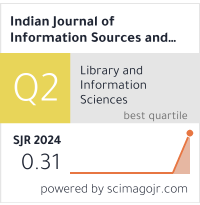Library Automation in First Grade Colleges Affiliated to University of Mysore: A Study
DOI:
https://doi.org/10.51983/ijiss.2020.10.2.492Keywords:
Library automation, college libraries, softwareAbstract
The present paperprovides the status of library automation of first gradecollege libraries affiliated to University of Mysore. A structured questionnaire was used as the tool to collect basic inputs from college libraries to understand the present status. A total of 160 colleges were taken up for the study in which 135(84.37%)colleges responded,15 first grade college libraries did not have librarians and 10 librarians did not respond.The findings of the study reveal that 60(63.83%)college libraries are using open source software E-Granthalaya and KOHA software for library automation. Out of 135 colleges,29 (30.85%) college libraries are fully automated, 65(69.15%) college libraries are partially automated and 41(28.90%) libraries are not automated. The librarians have to attend intensive training programs on deputation or have to become proficient on their own in automation in order to provide effective and efficient services to users.
References
Anas, M., Iqbal, J., & Ahmad, P. (2014). Impact of automation on library services in selected management institutes at Aligarh: A survey. The Electronic Library, 32(3), 296–307. https://doi.org/10.1108/EL-11-2011-0157
Bansode, S. Y., & Periera, S. (2008). A survey of library automation in college libraries in Goa State, India. Library Philosophy and Practice. www.webpages.uidaho.edu/mbolin/bansode-periera.html
Brahma, S. (2014). Problems and prospects of library automation in Bodoland Territorial Council area Assam. Retrieved from http://shodhganga.inflibnet.ac.in/bitstream/10603/39977/4/04_abstract.pdf
Breeding, M. (2008). Open-source library automation: Overview and perspective. Library Technology Report.
Haneefa, M. (2007). Application of information and communication technologies in special libraries in Kerala (India). Library Review, 56(7), 603-620.
Haravau, S. J. (1993). Library automation and networking in India – An overview of recent developments. ALIS, 40(1), 32-40. Retrieved from http://nopr.niscair.res.in/bitstream/123456789/27631/1/ALIS%2040%20(1)%2032-40.pdf
Husain, S., & Ansari, M. A. (2007). Library automation software packages in India: A study of the cataloging modules of Alice for Windows, Libsys, and Virtua. Annals of Library and Information Studies (ALIS), 54, 146–151.
Husain, S., & Nazim, M. (2015). Use of different information and communication technologies in Indian academic libraries. Library Review, 64(1/2), 135–153. https://doi.org/10.1108/LR-06-2014-0070
Ighovie Efe, S., & Benson Adogbeji, O. (2006). The assessment of the use of information and communication technology (ICT) in data storage and information dissemination in Nigerian meteorological stations. The Electronic Library, 24(2), 237–242. https://doi.org/10.1108/02640470610660404
Kemdarne, S. B. (2012). A study of library automation and networking in dental college libraries affiliated to Rajiv Gandhi University of Health Sciences, Bangalore. Retrieved from http://shodhganga.inflibnet.ac.in/bitstream/10603/5661/16/16_appendix%203.pdf
Kamath, V. A. (1990). Computer applications in library and information services: A brief survey of the world and information scenario. In H.A. Khan and S.R. Izari (Eds), Current problems and trends in library and information services (pp. 320). Varanasi, Indian Bibliographic Centre.
Moorthy, A. L. (2004). Library Automation in India.
Omoniwa, M. A. (2001). The computerization of Kashim Ibrahim Library of Ahmadu Bello University, Zaria, 1972-2001. Nigerian Libraries: Journal of the Nigerian Library Association, 35(1), 15-22.
Osahon Uwaifo, S. (2007). Age and exposure to computers as determinants of attitudes of librarians towards automation in Nigerian universities. Library Review, 56(6), 495–504. https://doi.org/10.1108/00242530710760391
Otunla, A. O., & Akanmu-Adeyemo, E. A. (2010). Library Automation in Nigeria: The Bowen University Experience. African Journal of Library Archives and Information Science, 20(2), 93–102.
Sanni, G. A., & Idiodi, E. A. (2004). Library computerization at the University of Benin, Nigeria. African Journal of Library, Archives and Information Science, 14(1), 65-76.
Sani, A., & Tiamiyu, M. (2005). Evaluation of automated services in Nigerian universities. The Electronic Library, 23(3), 274–288. https://doi.org/10.1108/02640470510603679
Suku, J., & Pillai, M. G. (2005). Automation of University Libraries in Kerala: Status, Problems, and Prospects. The Journal of Academic Librarianship, 31(2), 151–159. https://doi.org/10.1016/j.acalib.2004.12.007
Tripathi, D., & Pandey, S. (2019). Technological competencies of professionals and challenges in using and implementing Koha in Indian libraries. Annals of Library and Information Studies (ALIS), 66(2), 76–79.
University of Mysore. (n.d.). http://www.uni-mysore.ac.in/english-version/
National Assessment and Accreditation Council (NAAC). (n.d.). http://naac.gov.in/
Downloads
Published
How to Cite
Issue
Section
License
Copyright (c) 2020 The Research Publication

This work is licensed under a Creative Commons Attribution-NonCommercial-NoDerivatives 4.0 International License.









